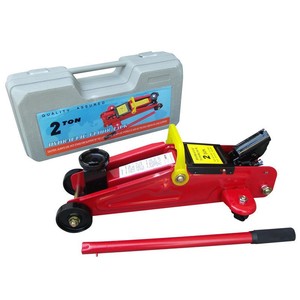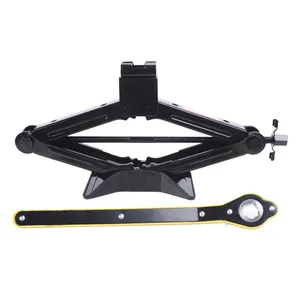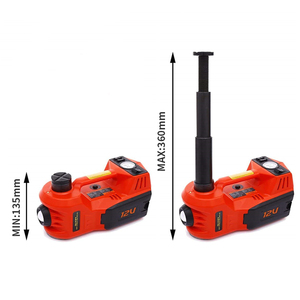(63499 products available)






























































































































































































A car jack for car is a device used to lift a vehicle so that repairs can be made underneath it. There are several different types of car jacks, each with its advantages and disadvantages. Here are some of the most common types:
Scissor jack
A scissor jack has a simple mechanism that looks like a pair of scissors. When the top handle is pushed up and down, the two arms of the jack move apart or together. This raises and lowers the lifting arm. A scissor jack is compact and easy to carry in the trunk of a car. However, it takes a lot of effort to use a scissor jack, and it can be dangerous to use on uneven ground.
Hi-lift jack
A hi-lift jack is a long lever jack used for lifting 4WD vehicles in off-road situations. The hi-lift jack is very powerful and can lift a vehicle to a great height. It can be used as a winch or a spreader. The hi-lift jack can be used on many types of terrain. However, the hi-lift jack is very tall and can be dangerous if not used properly. It is also heavy and difficult to carry.
Bottle jack
A bottle jack gets its name from its shape, which looks like a bottle. It is a hydraulic jack that uses the power of a piston to lift heavy loads. A bottle jack is compact and easy to carry. It is also very powerful and can lift a lot of weight. However, a bottle jack has a small base and can tip over easily. It is also difficult to use on uneven ground.
Floor jack
A floor jack is a hydraulic jack that is used to lift vehicles in a garage. A floor jack has a large base, so it is stable and safe to use. It can lift a vehicle quickly and to a great height. However, a floor jack is heavy and difficult to carry. It is also dangerous to use on uneven ground.
Electric jack
An electric jack is a hydraulic jack powered by an electric pump. Electric jacks are easy to use because they require little effort to lift a vehicle. They are also safe and stable to use. However, electric jacks are expensive and heavy. They can be dangerous to use if the battery is low.
Car jack for car is made with different materials to meet different lifting capacities. Here are some common car jack specifications:
Lifting capacity
Each car jack has its own weight-lifting limit. When choosing a car jack, consider the weight of the car. A jack with a lifting capacity of 1.5 tons will be suitable for a small car. For SUVs and trucks, opt for a jack with a lifting capacity of 3 tons.
Height
Different car jack types have different heights. Taller jacks will be more convenient for users. A tall jack will require fewer pumps to lift the car to the desired height.
Material
Car jacks are constructed from different materials like aluminum and steel. Jack made from aluminum is lightweight. Those made from steel are more durable.
Load rating
Load rating is the maximum weight that can be supported at any time. It is advisable to choose a jack with a higher load rating than the car's weight. This is to ensure safety and stability when lifting the vehicle.
Proper car jack maintenance is very important to ensure safety and reliability. Here are some car jack maintenance tips:
With so many options available for car jacks, it’s not always obvious which one is the best for a specific vehicle or use case. Here are some tips for selecting the right car jack:
Below is a general guide on how to replace a car jack.
Safety Precautions:
Before starting the replacement process, it is crucial to read the owner's manual of the car jack for cars and understand the safety precautions. Also, ensure to put on safety glasses and gloves for protection.
Prepare the Vehicle:
To ensure the car jack replacement process goes smoothly, park the vehicle on a level surface. Also, turn the ignition off, engage the parking brake, and ensure the wheel closest to the jack is chocking.
Locate the Old Jack:
After preparing the vehicle, the next step is to locate the old car jack. This is done by referring to the car jack for cars owner's manual. Once found, inspect the old jack to see how it is mounted and detached.
Remove the Old Jack:
To remove the old car jack, use the appropriate tools to unscrew and unbolt it from its mounting location. After removing the old jack, clean the mounting area and ensure it is free from rust and debris.
Install the New Jack:
First, assemble the new car jack for a jack if required, and then follow the manufacturer's instructions. After this, secure the new jack with the appropriate fasteners and bolts.
Test the New Jack:
Once the new car jack is secured in place, test it to ensure it functions properly. This is done by following the manufacturer's instructions and raising and lowering the jack without load.
Final Check:
After testing the new car jack, ensure all tools used during the process are removed from the vehicle. Also, ensure the mounting area is clean and free from debris. Finally, close the car jack for a jack handbook and keep it in a safe place.
Q: What is the lifting capacity of a car jack?
A: Car jacks have different lifting capacities. The minimum capacity is 1,500 pounds, while the maximum weight a car jack can lift is 3,000 pounds. However, the exact weight depends on the type of jack.
Q: Why should people use a jack when changing tires?
A: It is dangerous to change tires without a jack. If a driver attempts to change a tire without a jack, the vehicle may roll over and cause serious injuries. A car jack creates a stable environment by lifting the vehicle and allowing the driver to change the tire safely.
Q: How long does it take to change a tire using a car jack?
A: Changing a tire using a car jack can take anywhere from 30 minutes to an hour, depending on the mechanic's skill level, the jack's speed, and the tire-changing process. However, this can be much faster if the mechanic is experienced and the equipment is efficient.
The web search volume for the keyword "car jack for car" has shown significant fluctuations over the past year, with an average monthly web search volume of 8100. Notably, there has been a 50% increase in web search volume over both the three-month and one-year periods. The data reveals a notable peak in August 2024, where web searches surged to 14800, contrasting with a steady 6600 web searches in the months preceding and following this peak.
Analyzing the trend, the web search volume for "car jack for car" remained relatively stable at around 6600 web searches from December 2023 through July 2024. However, a sharp increase in August 2024 suggests a seasonal influence or a specific event that prompted more consumers to search for this product. Post-August, the web search volume returned to its previous level, indicating a temporary spike. Additionally, a noticeable increase in November 2024 to 9900 web searches could be associated with pre-holiday shopping or end-of-year vehicle maintenance trends.
The detailed examination of monthly data for "car jack for car" highlights periods of increased interest, potentially tied to specific events or seasonal behaviors among consumers. This pattern of web search volume fluctuations underscores the dynamic nature of consumer interest in vehicle accessories, influenced by various factors including seasonality and market events.